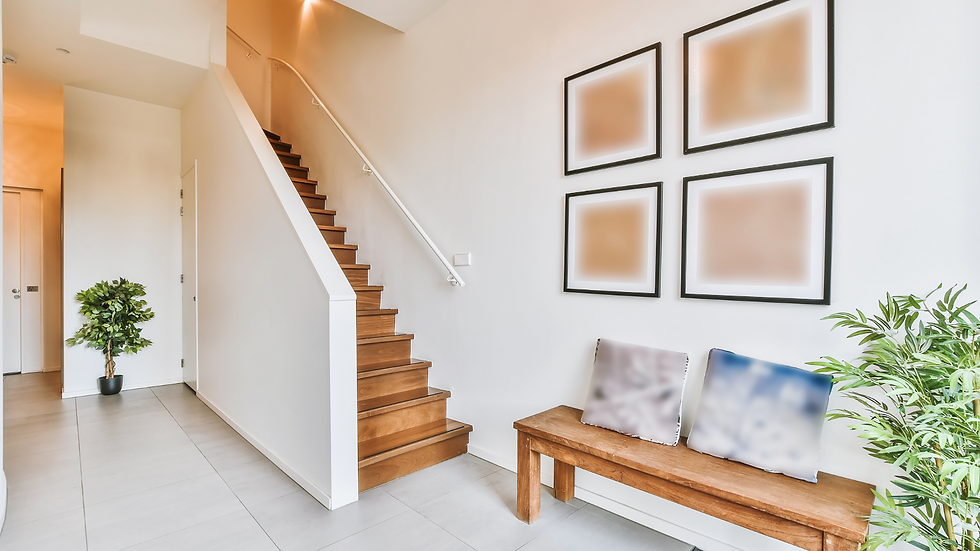How Many Steps Require a Railing Indoors? Find Out Here
- Up Stairs Rails

- Jul 2
- 5 min read

You’d be surprised how often homeowners stop mid-project and ask, “Wait… do I need a railing for just one step?” It usually comes up somewhere like the single step between a hallway and a sunken living room, or that little rise into a split-level foyer. It doesn’t look like much — and technically, it might not be.
But code isn’t always about what looks risky. It’s about height, traffic flow, and who’s using the space. That one lonely step might not faze you, but it could trip up a toddler, a dog, or your mother-in-law on a rainy day.
So… does one step need a railing?
Sometimes yes. Sometimes no. The answer depends on your layout, your lifestyle, and what the building code has to say about it — which is where we’re heading next.

What the Building Code Says About Indoor Railings
IRC Code Rules for Stairs
Let’s start with the basics: most residential building codes in the U.S. follow the IRC — the International Residential Code. And when it comes to indoor stairs, the rules are actually pretty specific.
Handrails are required when a staircase has four or more risers.So if you’ve only got one, two, or even three steps inside your home? Technically, you’re off the hook.
But there’s another layer — guardrails, which are different.Guardrails are only required when there's a drop of 30 inches or more, usually along open landings or loft-style levels.
They’re designed to prevent serious falls, not just help you steady yourself going up or down.
So the quick code takeaway?
4+ risers = handrail required
30"+ drop = guardrail required
Anything less? Technically optional — but that doesn’t always mean it’s the best choice for your space.
Want to dig into the official code? You can check it out according to IRC R311.7.8.
If you want to better understand the difference between guardrails and handrails — and where each one applies — head to our full guide on when handrails are officially required indoors.
What About 1 to 3 Steps?
Here’s where things get a little murky. If you’ve got a short run of stairs — just one, two, or three risers — the IRC doesn’t require a handrail. So technically, you can leave it out and still pass inspection… in most cases.
But some local codes (especially in New Jersey) add their own rules. Certain towns may flag safety concerns during a remodel, even if your step count is below the threshold. It’s not super common, but it happens — and no one wants to find that out mid-project.
And beyond code? It’s still worth thinking about who’s using the space. Is it near a doorway? Used often? A spot where your dog bolts through or grandma might lose her footing?
Even if the code gives you the green light, your real-life layout might tell you something else.
Curious how local code can impact your railing decisions? We broke it all down in this quick guide.

Handrails vs. Guardrails: Know the Code Lingo
This part trips people up all the time — and honestly, it’s easy to confuse the two. So let’s break it down.
A handrail is exactly what it sounds like: something your hand grips as you go up or down stairs. It’s there to help you keep your balance and move safely from one level to another. You’ll usually see handrails mounted on the wall or integrated into a railing system.
A guardrail, on the other hand (pun intended), is meant to keep you from falling off an open edge. Think of those half walls or open sides along a staircase or landing — especially where there’s a big drop. That’s where a guardrail comes in. It’s less about guiding your hand and more about protecting your body.
Inside most homes, you’re typically dealing with handrails only. But if your space has an open staircase, a loft-style second floor, or a split-level landing, both can come into play — and the code might require a combination setup to meet safety standards.
Still, the lines can blur, especially when people call everything a “railing” and leave it at that. But knowing which is which matters — not just for passing inspection, but for choosing a design that does its job without looking bulky or awkward. We cover more examples in our post on making safety choices that actually fit your home — especially when kids, pets, or aging parents are part of the picture.

Why You Might Want a Railing — Even If It’s Not Required
Just because a railing isn’t required doesn’t mean it’s always something to skip. Building code gives you the minimum — the baseline for safety — but every home has its own quirks.
If there’s a short set of steps in a high-traffic area, a spot where people naturally reach out for balance, or a transition that feels a little awkward, it might be worth considering a railing. Not because you have to, but because it makes the space feel more secure, more finished — more livable.
It’s especially helpful in homes with young kids, older relatives, or even just the occasional overnight guest who’s unfamiliar with the layout. And honestly, a well-placed handrail can also bring a sense of balance and structure to the room. It doesn’t have to be big or bulky. Sometimes, one subtle wall rail or a short wood-and-metal section can make the entire area feel more intentional.
The goal isn’t to overdo it — it’s to do what makes sense for your home.
And yes — bonus — it’s good for resale, too. Buyers notice the little things that make a home feel finished and thoughtful.
A well-placed railing adds both safety and perceived value — especially when it matches the rest of your home’s style. We dive into that in this blog.
Want to nerd out on why inspectors often recommend railings even when they’re not technically required? This stair and guardrail safety guide from InterNACHI is a solid resource.

Final Takeaway: It’s Not Just About Code
Sure, the building code might say you don’t have to add a railing — but it doesn’t know your home. It doesn’t know about your dog that jumps off the step like it’s a launchpad, or your mom who’s visiting for the weekend and needs something to grab onto, or the way your toddler insists on walking everywhere now, unassisted, with juice in hand. Code is written for the general public. Your home is personal.
And that’s why it’s okay — smart, even — to go beyond the minimum. Adding a small, intentional railing where you technically don’t have to isn’t just about safety. It’s about care. It's about finishing a space with thought, and making it feel complete, not just “compliant.”
You don’t need a massive install or a complicated design. Sometimes all it takes is one clean handrail or a short, subtle post to make your space safer, easier to use, and a whole lot more polished. If you need indoor railings in New Jersey, we’re here to help. Contact us for a Free Estimate!









Comments